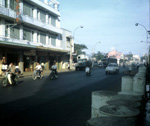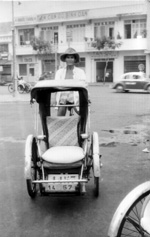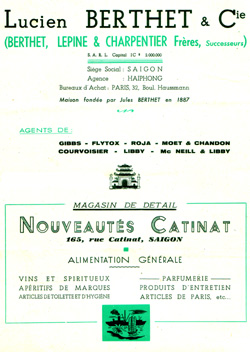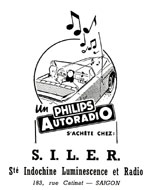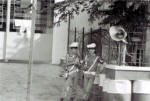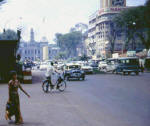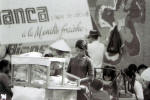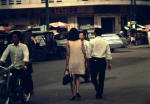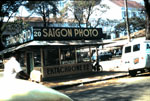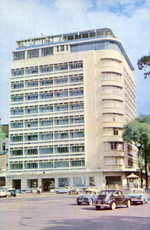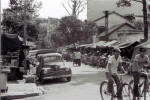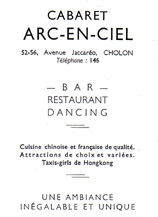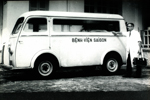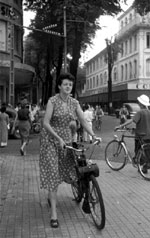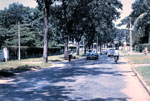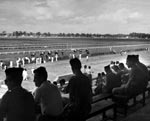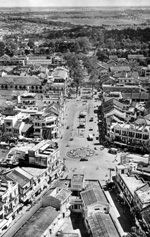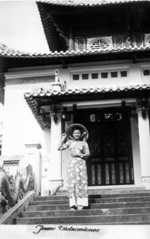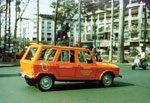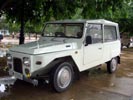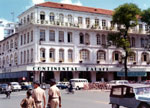
The Bank of Indochina
(now National Bank of Vietnam)
The Bank of Indochina, a private French bank founded in 1875, controls the entire Vietnamese economy, it was located at :
Quai de Belgique (Belgium Embankment now Bến Chương Dương)
Saigon
A branch is located at 178 LeLoi Street (Eden Passage) as well as in Cholon.
The headquarters of the Bank of Indochina is located at 96 Boulevard Haussman, in the 8th district of Paris.
The Bank of Indochina was bult in 1930, out of Bi├¬n Ho├á granite, by the architect F├ęlix Dumail, with:
- on the outside, columns inspired by Khmer archictecture.
- on the inside, a magnificent Art Deco style.
The value of the Piaster in the 1950ÔÇÖs.
The Piaster was the monetary unit of French Indochina. The Bank of Indochina had the monopoly on the minting of the Indochinese Piaster.
In 1953 the President of the Council, Ren├ę Mayer set the exchange rate for the Piaster at 10 Francs.
Therefore, 100 Francs (1950) = 1 New Franc (1958) = 0.5ÔéČ = 5.88 Piaster ($).
Banknotes issued by the Bank of Indochina
Price of transportation around town;
Booklet for French military personnel.
Transportation around town was at the following approximate tarifs :
a-By cyclo-ricksha (only one person allowed)
- An ordinary trip.......................... 2 $
- - A long trip.............................. 3 à 4 $
- - By the hour............................ 15 $
b-By Moped (two persons allowed)
- An ordinary trip.......................... 4 $
- A long trip................................. 8 $
- By the hour.............................. 25 $
c- By Taxi
- Theater Square
- Bonard Boulevard
The 4 CV Renault taxis are among the more interesting means of transportation, because the amount to be paid is registered on a meter. .
For other taxis (American cars), one needs to inquire as to the tariff before being driven.
An average amount was about 40 Piasters per hour.
In the event of a dispute, the tariff is posted inside each vehicle.
Check it.
The 4 CV Renault taxis

|
Phu Tho The Saigon race track was built in 1893 and was long considered to be the most famous of Southeast Asia. Tong-Doc-Phuong Boulevard and at the background the Saigon race track "Phu Tho". My-Canh This floating restaurant on the Saigon river was destroyed on June 25, 1965 by two powerful bombs. |
The Bank of East Asia 11, Lefevre street The tomb of Marshal Le Van Duyet Located 3 Km from the city center, the temple was restored during the 1930ÔÇÖs by the French School of the Far East. It is dedicated to General Le Van Duyet (1763-1831), a friend of the French, hence his current disgrace. |

Espagne (Spain) Street
(now Lê Thánh Tôh)
Soci├ęt├ę Automobile d'Extr├¬me-Orient
Far-East Automobile Company
Citroen Branch in Indochina
37, Espagne (Spain) Street
Saigon
The front wheel drive sedan was imported by Citroen into Indochina starting in 1936 up to 1957 through its Indochinese branch.
It was the car of French government workers as well as of the Indochinese middle class of European and Asian heritage.
The Front wheel drive sedan remains the mythical car of the colonial period in the collective memory of the Vietnamese; it remains to this day the symbol of certain hotels, notably the Hanoi Sofitel, as well as of museums and local luxury tour operators for tourists in Hanoi or Saigon.
Soci├ęt├ę Industrielle et Commerciale
Xe Hoï Citroen Cong Ty
In the 1970's, the Soci├ęt├ę Automobile d'Extr├¬me-Orient became the Soci├ęt├ę Industrielle et Commerciale "Xe Ho├» Citro├źn Cong Ty"
37, Lê-Thanh-Ton
Saigon
The Vietnamese 2 CV
This company assembled in Sa├»gon until 1975 the vietnamese M├ęhari the "Dalat" specially adapted to the South Vietnamese roads.
The Dalat was available in a number of different versions.
ENJOY YOUR TOUR OF DUTY IN VIETNAM
With the model 2HP. Citro├źn 1966 for US. $ 1250.00 delivered in Saigon
Wonderful 4 door convertible
with an extraordinary resale value market.










